The European photovoltaic mounting system market is experiencing rapid growth, driven by the rapid adoption of renewable energy and supportive government policies. As the structural backbone of solar installations, mounting systems are increasingly essential, improving energy generation, installation efficiency, and system durability. The market is expected to increase from USD 58,794.5 million in 2025 to USD 260,720.8 million by 2035, leading a CAGR of 16% during the forecast period.
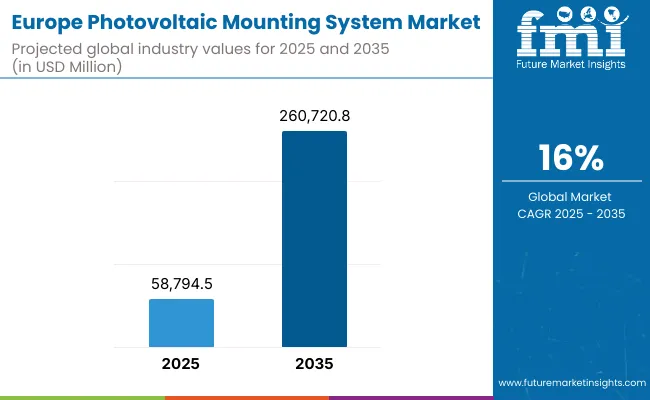
| Metric | Value |
|---|---|
| Market Size (2025E) | USD 58,794.5 million |
| Market Value (2035F) | USD 260,720.8 million |
| CAGR (2025 to 2035) | 16% |
Its robust regulatory framework, designed to drive down carbon emissions and reduce dependency on fossil fuels, has made solar PV a pillar of the EU’s energy strategy. Residential, commercial, industrial, and utility-scale photovoltaic mounting systems are being deployed at an increasingly rapid pace, and both rooftop and ground-mounted arrays are gaining traction. Germany and Spain are leading the way in these two countries, followed by Italy and France. Feed-in tariffs, green financing, and net metering schemes have also aided solar photovoltaic projects.
To meet the diverse needs of different roof terrains, mounting system manufacturers are now targeting various lightweight and corrosion-resistant materials, such as aluminum alloys and galvanized steel. The increasing demand for quick-install systems, adjustable tilt designs, and bifacial-compatible structures is influencing innovation across the market. With the discovery of utility projects, trackers are increasingly being used to maximize yield, and fixed-angle, ballasting systems dominate the urban residential and commercial segments.
Technologies such as AI-assisted solar tracking, automated installation, and modular frame systems are also paving the way for higher deployment speeds and lower labor costs. And the upcoming transition in the region toward climate neutrality will continue to drive demand for innovative mounting solutions, large-scale solar parks, building-integrated PV, and floating PV installations.
In Northern Europe, snow-stopping and bifacial-friendly mounting systems made for rooftops and ground-based solar farms are flying off the shelves. Sweden, Finland, and Denmark countries are integrating solar PV in residential and commercial energy systems, where it favours for its corrosion resistant structures and weathered climates. Elevated mounting systems are also a growing trend in urban projects in dense markets where space is limited and snow load tracking is critical.
The European regional market is dominated by the countries of Western Europe which is propelled by aggressive solar deployment targets, feed-in tariff programs, and utility scale solar investments. Countries such as Germany, France and the Benelux region are quickly scaling up both rooftop and ground-mounted PV deployments. Demand for aluminum and steel mounting frames with quick-install features for large format modules is particularly strong. In response, manufacturers are focusing on recyclable materials and automation-ready systems to align with regional sustainability goals.
High solar irradiance in southern Europe makes the region suitable for widespread on-site solar PV deployment in agriculture, residential and commercial fields. Countries such as Italy and Spain and Portugal are expanding rooftop solar and agrivoltaic systems while increasingly utilizing tilt and tracking structures to maximize output. Mounting systems featuring dust-resistant coatings and low-maintenance structures are preferred in these sun-intense locales.
Eastern Europe is a growth market after EU energy transition and solar infrastructure funding. Countries like Poland, Romania and Bulgaria are putting solar projects on deindustrialized land and incorporating PV solutions into municipal and rural energy programs. The market here has a preference for low-cost fixed-mount systems but is also slowly moving toward modular, tracker-based platforms in larger utility-scale projects.
Challenges
Land Constraints, Permitting Delays, and Climatic Stress
In urban and heritage environments where space is limited and aesthetics must comply with various standards, the standardization of mounting systems is challenging to deploy. Long permitting times across all EU jurisdictions delay project timelines. Variable climatic conditions across Europe ranging from high snow loads in the north to high temperatures in the south mandate region-specific engineering, increasing cost and complexity.
Opportunities
Demand for Agile Installation and Carbon-Neutral Infrastructure
This is particularly relevant for temporary/ mobile systems that need to be quickly deployed without tools and easily disassembled. Europe’s move to carbon-neutral infrastructure is creating new opportunities for recyclable, low-embodied-carbon mounting materials. Technological advances in dual-axis trackers, rooftop elevation structures, and AI-enhanced alignment systems are anticipated to significantly alter performance and design expectations in the market.
The market was supercharged by pandemic recovery stimulus between 2020 and 2024, higher electricity prices and a reinvigorated EU Green Deal commitment. On the other hand, governments were focused on distributed energy and local energy communities which lasted the period resulting in a rapid spread of rooftop PV in residential as well as C&I segments. Urban rollouts standardized on lightweight mounting frames, preassembled kits, and quick bolt systems.
From 2025 into 2035, the industry will transition toward next-gen mount platforms that accommodate ultra-large solar modules, smart integration with storage and co-location alongside agriculture or transportation infrastructure. Floating and vertical PV systems will also need custom anchoring and wind-resistant frames. The era of digital twins and embedded monitoring for structural health assessment will come under premium offerings. Others, like policy harmonization and recycling mandates, will push suppliers towards eco-efficient designs and end-of-life management protocols.
Market Shifts: A Comparative Analysis 2020 to 2024 vs. 2025 to 2035
| Market Shift | 2020 to 2024 Trends |
|---|---|
| Technology Focus | Fixed tilt and single-axis trackers |
| Demographic Penetration | Residential and commercial rooftops |
| Treatment Settings | On-grid rooftop arrays |
| Geographical Growth | Germany, France, Italy |
| Application Preference | Urban solar rooftops and industrial sheds |
| Cost Dynamics | Focus on low-cost aluminum frames |
| Consumer Behaviour | Cost-per-watt driven procurement |
| Service Model Evolution | Product-centric sales |
| Market Shift | 2025 to 2035 Projections |
|---|---|
| Technology Focus | Smart dual-axis systems, modular AI-integrated structures |
| Demographic Penetration | Utility-scale solar parks, agri-PV, floating PV |
| Treatment Settings | Hybrid installations with storage and microgrids interfaces |
| Geographical Growth | Spain, Nordics, Eastern Europe, Alpine regions |
| Application Preference | Dual-use land, parking canopies, and retrofitted public buildings |
| Cost Dynamics | Rise of premium-grade recyclable and rapid-installation systems |
| Consumer Behaviour | Lifecycle value and environmental impact awareness |
| Service Model Evolution | Full-scope EPC + structural health monitoring and recycling services |
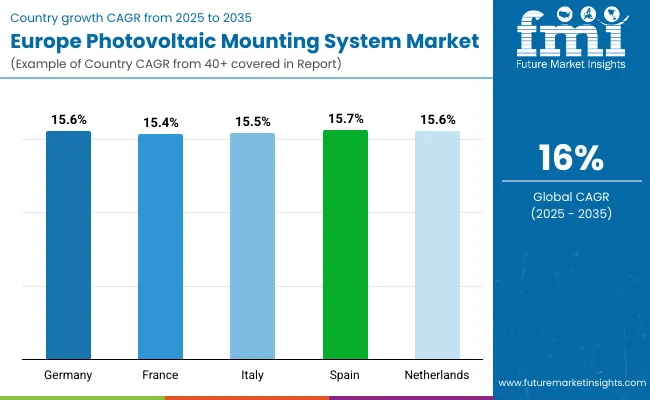
Europe photovoltaic mounting system market is dominated by Germany, owing to the high solar PV deployment amount, lucrative feed-in tariff, and developed rooftop infrastructure. Germany’s transition to renewable energy, or Energiewende, continues to spur investments in residential as well as commercial rooftop installations. With the add-on of solar carports in logistics parks and other public infrastructure the demand for the system is also increasing in leaps and bounds.
| Country | CAGR (2025 to 2035) |
|---|---|
| Germany | 15.6% |
Strong momentum for ground-mounted photovoltaics France in part, government auction schemes for solar thermal area and other rural photovoltaic performance While ground-mounted structures are optimized increasingly for large installations on agricultural and unused land. They will spend on modular, corrosion-resistant mounting systems enhanced with the ingenuity of performance-based design for mounted structures to ensure longevity compliance as per terrain.
| Country | CAGR (2025 to 2035) |
|---|---|
| France | 15.4% |
High solar irradiance and a known pathway for rooftop subsidies in Italy propels residential and commercial adoption of PV systems. Rooftop mounting systems cover the majority of the Italian market, especially within urban environments where energy self-consumption is supported. Types of roofs used by affordable commercial builder’s lightweight, angled roof structures that comply with local zoning laws are preferred.
| Country | CAGR (2025 to 2035) |
|---|---|
| Italy | 15.5% |
Spain’s photovoltaic growth strategy combines utility-scale projects with an energy mix in which independent power producers (IPPs) play an ongoing role. While the country's first ground-mounted systems dominate, rooftop installations on industrial and commercial buildings are taking off quickly. This approach promotes competitive differentiation in mounting solutions with faster deployment cycles through B2B partnerships with installers and technology providers.
| Country | CAGR (2025 to 2035) |
|---|---|
| Spain | 15.7% |
The Netherlands also has one of the highest per-capita rates of solar PV installations in Europe: workers have placed solar panels on the rooftops of many residential, retail, and logistics buildings. The increasing density of the urban landscape will make carport mounting systems an increasingly attractive segment. The market is further being bolstered by policy backing for decentralized solar electricity generation and integration into EV charging networks.
| Country | CAGR (2025 to 2035) |
|---|---|
| Netherlands | 15.6% |
The Europe photovoltaic mounting system market is further segmented on the basis of product type into rooftop product type, ground mounted product type, and carport mounting structure; and on the basis of sales channel into business to business (B2B) and business to customer (B2C). Commercial systems dominate the mix followed by rooftops, driven by solar self-consumption trends, net-metering policies, and growing residential solar programs.
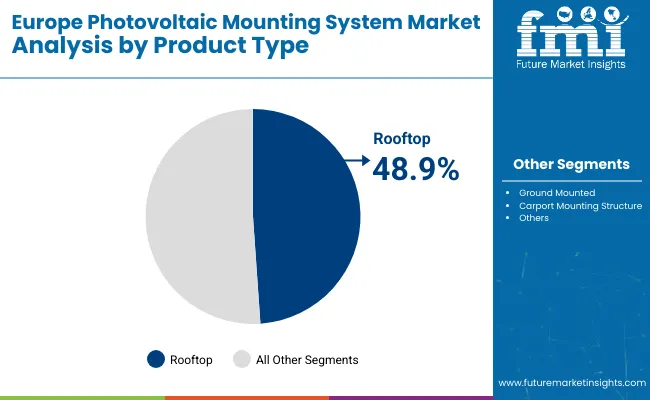
| Product Type Segment | Market Share (2025) |
|---|---|
| Rooftop | 48.9% |
In 2025, rooftop systems are expected to account for 48.9% of the European market. Streamlined permitting and tax incentives are viewed as the backbone of installations on homes, retail stores and industrial warehouses. Innovations in mounting systems, including low-profile frames, tilt-in rails, and dual-function roofing solutions (such as solar shingles), facilitate their adoption in dense cities.
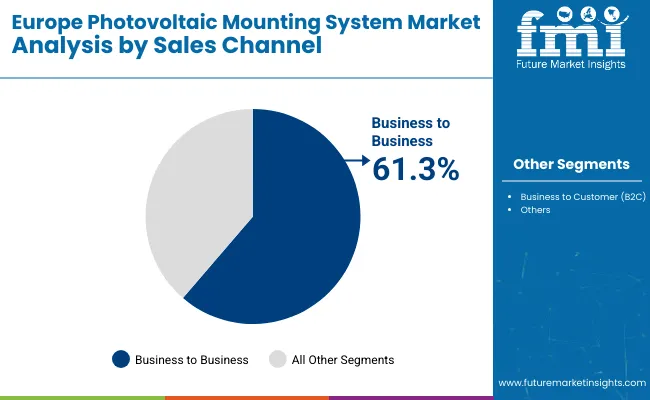
| Sales Channel Segment | Market Share (2025) |
|---|---|
| Business to Business | 61.3% |
B2B will account for 61.3% of sales by 2025; EPC firms will continue to be major buyers of mounting systems. These companies prefer mounting kits that can be preassembled and scaled down to minimize installation time and labour costs. Supply contracts with solar farm developers, public housing authorities and construction firms amplify volume purchases through B2B channels.
Rapid innovation in materials has increased durability and allowed for faster assembly and installation times, which are mutually beneficial to both manufacturers and patrons, and are expected to see high competitive rates in the Europe photovoltaic mounting system market. Major players are concentrating on lightweight aluminum alloys, corrosion-resistant coatings, and tilt-adjustable mechanisms.
Additional value propositions are being offered through installation services and structural engineering support by the companies. Ground-mounted and carport systems are driving market growth due to strategic partnerships with utility-scale developers and urban planners.
Market Share Analysis by Key Players
| Company Name | Estimated Market Share (%) |
|---|---|
| Schletter Group | 16-19% |
| Mounting Systems GmbH | 13-16% |
| K2 Systems | 12-15% |
| Renusol Europe GmbH | 10-13% |
| Others | 37-42% |
| Company Name | Key Offerings/Activities |
|---|---|
| Schletter Group | In 2025, the ProLine series was introduced, featuring ultralight and aerodynamic rooftop frames for residential photovoltaic (PV) systems. |
| Mounting Systems GmbH | In 2024, Sigma II was introduced for ground-mounted systems, featuring a modular profile for faster utility-scale deployments. |
| K2 Systems | In 2025, developed the Dome Zero EV for EV-integrated solar carports with anti-slip and angled drainage design. |
| Renusol Europe GmbH | In 2024, expanded its rooftop mounting portfolio with rail-less clip systems for low-pitch metal and tile roofs. |
Key Market Insights
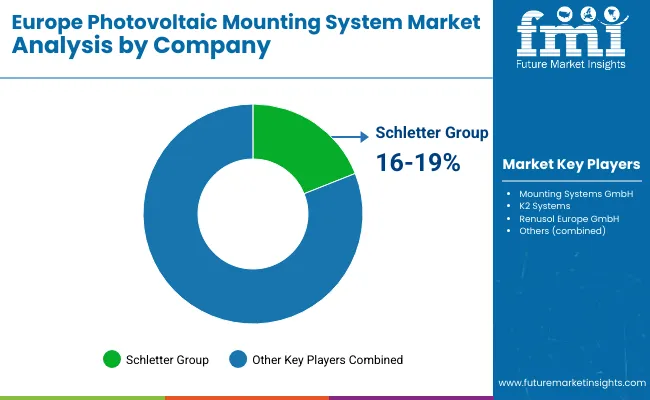
Schletter Group (16-19%)
Schletter continues to lead with its engineering-focused mounting solutions, widely adopted in rooftop and utility-scale applications across Germany and France. Its ProLine series is renowned for its aerodynamic efficiency and reduced wind loads, making it an ideal choice for installations in challenging climates.
Mounting Systems GmbH (13-16%)
Mounting Systems offers ground and rooftop mounting structures, focusing on fast deployment and structural safety. The Sigma II line is gaining traction in large utility-scale projects across Eastern and Southern Europe due to its tool-less design and high structural integrity.
K2 Systems (12-15%)
K2 Systems remains a pioneer in carport and rooftop installations, particularly for residential and EV charging infrastructure. The company’s innovation in drainage systems, rail layout design, and corrosion protection adds value for installers in the Netherlands and Italy.
Renusol Europe GmbH (10-13%)
Renusol’s compact, rail-less systems reduce material use and ease rooftop compatibility, especially in densely built urban zones. Its flexible product range and pre-assembled kits are popular among European contractors seeking speed and versatility.
Other Key Players (37-42% Combined)
The market size in 2025 was USD 58,794.5 million.
It is projected to reach USD 260,720.8 million by 2035.
Key growth drivers include rapid expansion of solar energy adoption, favorable government incentives, and growing need for durable and efficient mounting structures for residential, commercial, and utility-scale solar projects.
The top contributors are Germany, Spain, France, Italy, and Netherlands.
The rooftop segment is expected to dominate the photovoltaic mounting system market in Europe.






Our Research Products

The "Full Research Suite" delivers actionable market intel, deep dives on markets or technologies, so clients act faster, cut risk, and unlock growth.

The Leaderboard benchmarks and ranks top vendors, classifying them as Established Leaders, Leading Challengers, or Disruptors & Challengers.

Locates where complements amplify value and substitutes erode it, forecasting net impact by horizon

We deliver granular, decision-grade intel: market sizing, 5-year forecasts, pricing, adoption, usage, revenue, and operational KPIs—plus competitor tracking, regulation, and value chains—across 60 countries broadly.

Spot the shifts before they hit your P&L. We track inflection points, adoption curves, pricing moves, and ecosystem plays to show where demand is heading, why it is changing, and what to do next across high-growth markets and disruptive tech

Real-time reads of user behavior. We track shifting priorities, perceptions of today’s and next-gen services, and provider experience, then pace how fast tech moves from trial to adoption, blending buyer, consumer, and channel inputs with social signals (#WhySwitch, #UX).

Partner with our analyst team to build a custom report designed around your business priorities. From analysing market trends to assessing competitors or crafting bespoke datasets, we tailor insights to your needs.
Supplier Intelligence
Discovery & Profiling
Capacity & Footprint
Performance & Risk
Compliance & Governance
Commercial Readiness
Who Supplies Whom
Scorecards & Shortlists
Playbooks & Docs
Category Intelligence
Definition & Scope
Demand & Use Cases
Cost Drivers
Market Structure
Supply Chain Map
Trade & Policy
Operating Norms
Deliverables
Buyer Intelligence
Account Basics
Spend & Scope
Procurement Model
Vendor Requirements
Terms & Policies
Entry Strategy
Pain Points & Triggers
Outputs
Pricing Analysis
Benchmarks
Trends
Should-Cost
Indexation
Landed Cost
Commercial Terms
Deliverables
Brand Analysis
Positioning & Value Prop
Share & Presence
Customer Evidence
Go-to-Market
Digital & Reputation
Compliance & Trust
KPIs & Gaps
Outputs
Full Research Suite comprises of:
Market outlook & trends analysis
Interviews & case studies
Strategic recommendations
Vendor profiles & capabilities analysis
5-year forecasts
8 regions and 60+ country-level data splits
Market segment data splits
12 months of continuous data updates
DELIVERED AS:
PDF EXCEL ONLINE
Photovoltaic Mounting System Market Analysis - Size, Share, and Forecast 2025 to 2035
UK Photovoltaic Mounting System Market Growth - Trends & Forecast 2025 to 2035
Europe Flare Gas Recovery System Market - Growth & Demand 2025 to 2035
Europe Home High End Audio System Market – Trends & Forecast 2025 to 2035
Europe Automotive Night Vision System Market Size and Share Forecast Outlook 2025 to 2035
Western Europe HVDC Transmission System Market – Growth & Forecast 2025 to 2035
Visitor Management System Industry Analysis in Western Europe - Market Outlook 2025 to 2035
Western Europe Battery Management System Market Growth – Trends & Forecast 2023-2033
Western Europe Building Automation System Market by System, Application and Region - Forecast for 2025 to 2035
Western Europe Social Employee Recognition System Market - Trends & Forecast 2025 to 2035
Artificial Pancreas Systems Market Analysis – Size, Demand & Forecast 2022-2032
Europe Wood Pellet Heating System Market Growth – Trends & Forecast 2024-2034
Semiconductors in Solar PV Power Systems Market Growth - Trends & Forecast 2025 to 2035
Photovoltaic Silane Coupling Agent Market Size and Share Forecast Outlook 2025 to 2035
Europe Radiotherapy Patient Positioning Market Size and Share Forecast Outlook 2025 to 2035
Europe Polyvinyl Alcohol Industry Analysis Size and Share Forecast Outlook 2025 to 2035
Europe Cruise Market Forecast and Outlook 2025 to 2035
Europe Massage Therapy Service Market Size and Share Forecast Outlook 2025 to 2035
Europe Cement Market Analysis Size and Share Forecast Outlook 2025 to 2035
European Union Tourism Industry Size and Share Forecast Outlook 2025 to 2035

Thank you!
You will receive an email from our Business Development Manager. Please be sure to check your SPAM/JUNK folder too.
Chat With
MaRIA